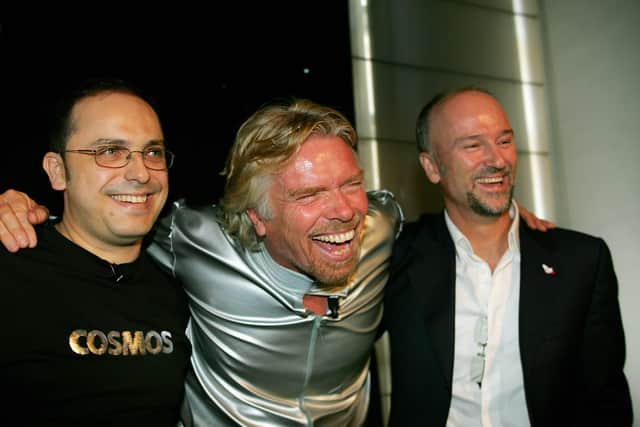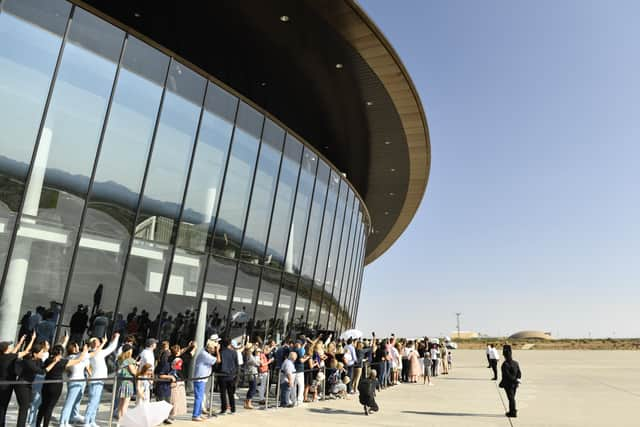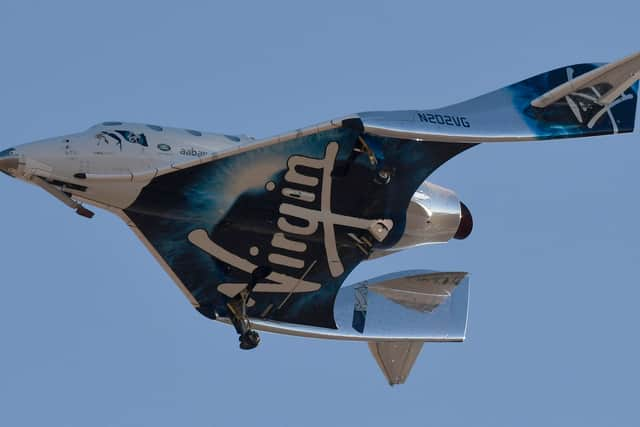Virgin Galactic; Sir Richard Branson’s fascination and the lengths he’s gone to for commercial space travel
People in this article
and live on Freeview channel 276
With any luck, the first commercial space flight for Virgin Galactic should be going ahead this week, with a scheduled launch time of 3pm on June 29 2023 from Spaceport America in New Mexico.
Though no celebrities will be aboard the flight, ‘Galactic 01,’ a number of important members from the scientific community will be conducting experiments and tests while floating in suborbit, as opposed to the luxury flights of one Blue Origin and its owner, Jeff Bezos.
Advertisement
Hide AdAdvertisement
Hide AdBut it’s not always going to be that case, with Virgin Galactic already offering ticketing services for those who wish to hop aboard the VSS Unity and take the 90 minute journey into suborbit, experiencing a period of weightlessness and viewing the Earth down below. Ideas that have fascinated entrepreneur Sir Richard Branson since a very early age.
Like many of his age, Branson grew up during the space race, when the United States and then Soviet Union were upping the ante being the first nations to land on the moon. Branson’s sense of adventure was in part born through watching such events as the Apollo moon landings, historic events that led the entrepreneur to long become almost obsessed with the idea of making space more accessible.
In his mind, he envisioned a future where people could experience first hand the awe-inspiring beauty and “transformative power” of space - the later comment becoming an integral part of Virgin Galactic’s credo since operations began. From that early age, Branson recognized the “untapped potential” of space tourism - but it would be a fair few years before these plans came to some semblance of reality.
2004 - The Birth of Virgin Galactic


If you were to hear a rich entrepreneur telling you that he planned for, at some stage, everyone to have the ability to travel into space (or, as it is on this occasion, suborbit the earth), you’d of thought you were listening to the latter day equivalent of Howard Hughes. But given that Sir Richard Branson had a litany of adventurous stunts under his belt, from hot air ballooning across the Atlantic Ocean to Kiteboarding Across the English Channel, his words seemed to have more persuasion regarding the matter.
Advertisement
Hide AdAdvertisement
Hide AdIn 2004, Virgin Galactic was born, establishing itself as part of Branson’s Virgin Group conglomerate. Under the subsidiary The Spaceship Company, Branson partnered with Mojave Aerospace Ventures and its owners Burt Rutan and Paul Allen, to create a space of fleet vessels capable of his childhood ambitions.
The development of Virgin Galactic gained significant momentum when SpaceShipOne, a spacecraft designed by Burt Rutan's company Scaled Composites, won the Ansari X Prize in 2004. This prize was awarded for achieving the first privately funded manned spaceflight and showed the world the viability of Branson’s plans for commercial space travel.
But where to launch his test flights from? Cape Canaveral, where much of NASA’s launches take place, was out of the question. Instead, with a commitment to space travel for the masses, Branson selected New Mexico as the site for Spaceport America. The US state's favourable geographic and meteorological conditions, along with its commitment to supporting commercial spaceflight, made it an ideal choice.
Spaceport America creation - 2005


To bring the vision of Spaceport America to life, a public-private partnership was formed between the State of New Mexico and Virgin Galactic. The state invested in the construction of the spaceport infrastructure, while Virgin Galactic committed to making it their primary operating base for space tourism.
Advertisement
Hide AdAdvertisement
Hide AdThe groundbreaking ceremony for Spaceport America took place in 2009, marking the start of construction on the facility. The design of the spaceport was led by renowned architect Lord Norman Foster. It features a distinctive and futuristic terminal building, designed to accommodate the unique needs of commercial space travellers.
The spaceport also serves as the operational hub for Virgin Galactic's space tourism activities, with the facility including various infrastructure elements, such as hangars, mission control, astronaut preparation areas, and a runway capable of accommodating both horizontal and vertical takeoff and landing vehicles.
Spaceport America was officially dedicated in October 2011, with Sir Richard Branson and his family in attendance. The dedication ceremony coincided with the unveiling of Virgin Galactic's VMS Eve and SpaceShipTwo vehicles. By collaborating with the state of New Mexico and investing in the development of a purpose-built spaceport, Branson laid the foundation for Virgin Galactic's operations and positioned the company as a pioneer in the field of space tourism.
Ignition sequence launched - 2008 - 2021


In 2008, the world met VMS Eve (VMS being short for “Virgin MotherShip''), a carrier aircraft designed to launch what was then called SpaceShipTwo - a suborbital spaceplane. The vessel was created to carry up to six passengers and two pilots, and embarked on a series of extensive testing and development phases to ensure the safety and reliability of the space vehicles.
Advertisement
Hide AdAdvertisement
Hide AdThese test flights of SpaceShipTwo, later to be known as VSS Unity (VSS being short this time for “Virgin SpaceShip”), were conducted to evaluate its performance and gather data for future space flights, which ultimately led to the even daring Branson to put his money where his mouth is and board one of the first manned flights of both the VMS Eve and VSS Unity.
One of the significant milestones for Virgin Galactic came on July 11, 2021, when Sir Richard Branson himself became the first passenger to travel to space aboard VMS Eve and VSS Unity. This historic flight, known as Unity 22, marked the company's first fully crewed mission and represented a major achievement for commercial space tourism.
In total, VSS Unity has made 22 test flights, with five of those successfully entering suborbit, and the 2021 flight Sir Richard Branson was on the first with a full payload (six passengers, two pilots). The launch of ‘Galactic 01’ this week is to demonstrate that the reality of commercial space travel, akin to Jeff Bezos’ recent Blue Origin project, is sooner than we all think.
How can I watch the launch of ‘Galactic 01’?
Virgin Galactic will be offering a live stream, tentatively scheduled for June 29 2023 at 3:00pm BST, over at their official Virgin Galactic website. However, given the nature of launches and the extremely delicate nature of them, there is always the possibility this would be delayed - hence the window of opportunity we keep mentioning.
Comment Guidelines
National World encourages reader discussion on our stories. User feedback, insights and back-and-forth exchanges add a rich layer of context to reporting. Please review our Community Guidelines before commenting.
